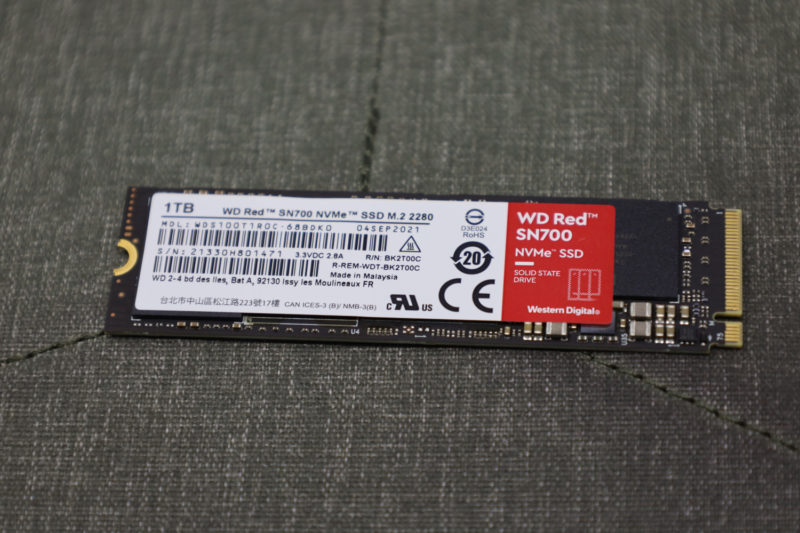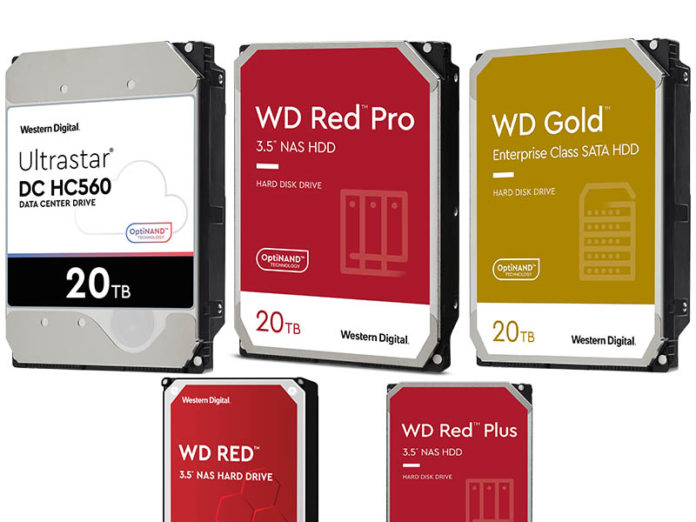WD this week, release its new WD Red Pro 20TB drives. Cliff had an interesting take and one that we have mentioned previously. Still, on this particular release, it is borderline shocking. The new WD Red Pro 20TB drive has an annual workload rating, over its five years, of only 300TB per year. If you read the footnotes, the practical impact is that that workload rating is much closer to consumer QLC SSDs than one may otherwise think just by looking at the figure.
You may look at the low-cost consumer SSD and typically we see anywhere from maybe 300TBW-900TBW as the workload rating on 1TB-2TB drives. Generally, with SSDs, endurance ratings increase with capacity because there is more NAND flash to wear out. Every major advancement in storing more in the same number of cells, such as SLC to MLC, MLC to TLC, and TLC to QLC has come with a decrease in endurance ratings, but most have not noticed since drive capacities have increased steadily. In the data center, I remember 40GB and 80GB SSDs being big, but now it is hard to get a data center SSD under 1TB. Endurance ratings on the consumer and NAS side are often not PBW, but there are many that get into that space.

So for many years, folks have said, hey hard drives, unlike SSDs, have higher endurance. That is not really the case anymore, and that even includes the high-end NAS drives from Western Digital.
We also have a video version of this that you can see here:
As always, we suggest watching this in a YouTube window, tab, or app for a better viewing experience.





Are the ratings about warranty or do the drives really fail that quickly? Since the 300TB limit takes a short time to write, it would be interesting to create an ZFS pool using around 8 drives and then alternatively delete files, write lots of data and then scrub to see whether errors are detected or a failure occurs. A parallel experiment with Toshiba drives would keep things interesting.
Looks like the same for Seagate’s IronWolf Pro line:
https://www.seagate.com/files/www-content/datasheets/pdfs/ironwolf-pro-20tb-DS1914-19-2112US-en_US.pdf
But in the Seagate data sheet it doesn’t specify if the “Workload Rate Limit” includes reads writes or just writes.
Eric – the big challenge with this, is that that is 8x $550 (after-tax) for the Red Pro alone, plus a test rig running for weeks. In the end, you only get a small sample size so even that is not overly useful.
Patrick — I think that for the sort of test Eric is thinking of, you don’t really need much sample size for it to be useful. Even 2 or 4 drives would probably tell you if the lowered endurance is real, and the host could be whatever you’ve got lying around.
The way I see it, there are two possibilities: newer HDD recording technologies like HAMR/MAMR really do decrease drive lifetime significantly and these lower limits reflect that, or WD artificially lowered that limit for market segmentation, and while they may be out of warranty when WD specifies, they’ll last as long as you’d expect from previous generations. Knowing which one it is would be useful, even if the sample size isn’t large enough to measure an actual endurance with any accuracy.
Nice article
Duplicate paragraph though
“Finally, the higher-end 7200 rpm line is the WD Red Pro. This is the high-end drive that you would reasonably think is the best drive on the market. This is not for low-end NAS-es. It is for higher-end NASes with up to 24 drives and that perhaps need higher performance.”
And this was the reason I absolutely refuse to buy Western Digital Drives at all now. At least Seagate is honest about the Endurance and it is only based on the Writes as like in an SSD, reads are practically free.
It is articles like these in-depth, brain-stretching analytical pieces where STH truly shines.
In cricket terms, I think this article has “hit for a six” in terms of quality reporting.
Seagate’s Ironwolf Pro series 12-20TB Helium CMR are all, also rated at 300 Worlkload Rate. See the current datasheet pdf. [1]
@Mike Sawyer
Seagate Workload rate is also read + write, see the following from seagate.com knowledge base:
“Current Seagate disk drives keep track of various drive usage such as power on hours, lifetime writes and lifetime reads from the host computer. With this data we can calculate an Annualized Workload Rate using this simple formula:
Annualized Workload Rate =
(Lifetime Writes + Lifetime Reads) * (8760 / Lifetime Power On Hours)” [2]
[1] https://www.seagate.com/files/www-content/datasheets/pdfs/ironwolf-pro-20tb-DS1914-19-2112US-en_US.pdf
[2] https://www.seagate.com/support/kb/annualized-workload-rate-005902en/
@Sleepy or in STHs ratings, a 6.4, 6.3, 6.2, 6.6
Ehhm, “<10 in 10^14" for errors they are writing in their datasheets? Thats super terrible as most consumer drives are <1 in 10^14 and datacenter drives usually are <1 in 10^15.
That would be translate in <1 in 10^13: factor 10 worse!
I notice that WD doesn’t even list a workload rating one way or another on their Blue and Black consumer hard drives.
For Red and Red Plus (which are the “regular” non-SMR Reds after SMRgate) WD is giving as mentioned 180TB/year.
I would say there is absolutely no data in this number, it’s just noise. It’s the same for drives from 1TB to 14TB, from 2011 until now, helium and air, low RPM and high(er) RPM drives, nonSMR and SMR drives, mostly 3.5″ but there’s even a 2.5″ (“LAPTOP” size) there! It’s all the types of drives that are vaguely common today!
This isn’t the result of any measurement, statistic or anything technical, it’s just something someone came up with and put there. We can only speculate WHY or WHO did that (I’d say the marketing department to push people that aren’t too technical or who aren’t spending their own money into buying a higher tier drive). But anyone who knows better should just ignore it, completely. That goes probably for the rest of the datasheets (at least from WD), unless of course it’s just to expose how laughable they are and be shocked “how they can say that with a straight face”.
You have repeated twice the paragraph that starts with:
Finally, the higher-end 7200 rpm…
I doubt the workload rating is actually meaningful, but it could be that the workload rating does not scale with capacity because it’s actually about the arm wearing out? That could possibly be universal across capacities.
I had also thought it might be about the heads, but then it should scale with the number of heads.
I sure hope this number was just pulled out of someone’s ass, or it really only includes reads.
After having two rebuild failures on homebuilt raid5 MD arrays in the past due to undetected bad blocks(yes, on tler capable drives!) I set up my Synology to do a full scrub of each of the arrays each week.
That alone would eat up almost all the life of the drives, if you believe their rating…
So can someone recommend a reliable 16tb drive for a RAID 6 Synology setup? Seams like every drive I look at has this doomed feeling to it.